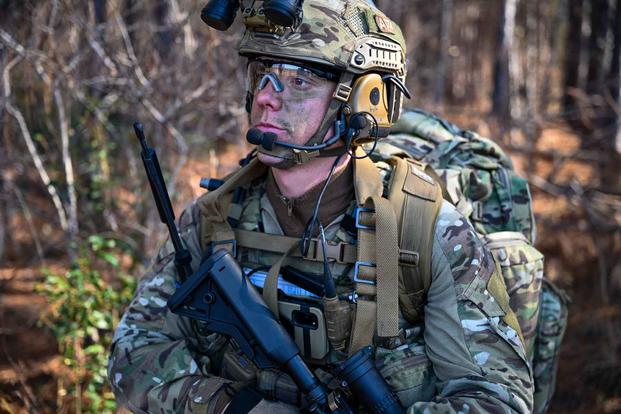An Air Force plan to relocate squadrons of elite close-air support airmen on Army bases, consolidating from eight locations down to just two, is alarming GOP lawmakers, who claim the move will harm military readiness and are pressing the service for more details.
Tactical Air Control Party airmen are part of a special warfare job in the Air Force and embed with other services, such as the Army and Marines, to help scout and guide air support in the heat of battle. It's one of the service's toughest jobs and involves rigorous physical training and hazardous assignments.
But the plan to reorganize multiple units located at Army bases across the country into just two locations may cause issues, GOP members of the House claimed in a letter to Air Force Secretary Frank Kendall.
"Any soldier who has been in a 'danger close' engagement and has trusted a TACP operator to call in effective fires will attest to the mutual trust they develop through close integration," the lawmakers wrote. "Breaking these relationships will create a gap in expertise at the expense of the warfighter and will force division commanders to assume greater risk across all domains."
Rose Riley, a department of the Air Force spokeswoman, confirmed to Military.com on Tuesday that the service selected Fort Cavazos in Texas and Fort Liberty in North Carolina to be the candidate locations for the active-duty TACP mission, but she added that "a final decision has not yet been made."
The Air Force is expected to reduce TACP by 484 airmen, and units at Fort Drum, Fort Bliss, Fort Riley, Fort Carson, Fort Stewart and Fort Campbell will be consolidated into the two existing units at the Texas and North Carolina bases, Riley said.
"The reduction and consolidation of the TACP enterprise to two locations is needed to best align the Department of the Air Force with the National Defense Strategy," Riley told Military.com. "This action creates necessary efficiencies to enable the [Air Force] to continue delivering critical capabilities for future joint force requirements."
GOP Reps. Elise Stefanik, Doug Lamborn, Buddy Carter, Jake LaTurner, Claudia Tenney, James Comer and Tracey Mann signed the letter addressed to Kendall. They all represent states that would be losing those TACP units.
"This rushed decision will jeopardize our service members' safety and negatively impact our nation's military readiness," Stefanik, who represents a New York district, said in a statement. "TACPs are an invaluable resource to the 10th Mountain Division and continuing to base these squadrons at Fort Drum will enable both TACPs and the 10th Mountain Division to maintain the necessary trust and proficiency required to execute short-notice global missions that are critical to our national security."
Lawmakers are asking Kendall to respond no later than Dec. 1 about which capabilities those bases will lose, whether the Air Force conferred with the Army about the plans, and "how this decision will impact the readiness of these U.S. Army divisions and will it impact their ability to rapidly deploy?"
Lawmakers' concerns over the Air Force's relocation efforts also come as the service plans to cut the number of TACP airmen by nearly 44% overall, from around 3,700 positions to 2,130 jobs, Military.com has previously reported.
Those cuts come as the Air Force seeks to reassess its close-air support capabilities amid escalating tensions with China, even looking to scrap more A-10 Thunderbolt II aircraft -- one of the main airframes that TACPs have worked with -- in the 2024 National Defense Authorization Act.
The Air Force is asking to decrease TACPs by roughly 370 positions in fiscal 2023, 610 positions in fiscal 2024, and 600 positions in fiscal 2025, the service previously told Military.com in a June emailed statement.
The Tactical Air Control Party field has remained, historically, around 80% manned, so the service would try to make cuts from that unmanned 20% first.
Riley told Military.com in June "there are no plans to retrain TACPs to other career fields in light of the manning reduction, but the Air Force is opening opportunities for those who would prefer to pursue other careers."
Troops-In-Contact, an advocacy group led by A-10 and air support veterans, issued a statement after the cuts were revealed earlier this year saying close-air support, or CAS, is crucial to the military. The group argued that the results of cutting TACPs could be deadly.
"If successful, this plan would kill the CAS profession and cripple America's CAS capability," the group wrote on its website. "Ground troops would be supported, if at all, by CAS amateurs in a small, expensive fleet of fragile aircraft that are far less effective. In low-intensity conflict, that will cost lives."
The group has also fought against cuts to the A-10, known as the Warthog. The close-support aircraft with a more than 57-foot wingspan has been flown by the military since the 1970s. Known for its menacing 30mm Gatling-style guns, the aircraft protected troops in Iraq and Afghanistan, as well as the first Gulf War.
For decades, the Air Force's efforts to send its A-10s to the boneyard have been stymied by Congress. Last year, however, in the annual defense authorization bill, Congress finally allowed 21 of the planes to be retired, which marked the first retirements of that aircraft in the 21st century.
The Air Force is seeking to double that number of retirements to 42 aircraft in the 2024 defense bill.
-- Thomas Novelly can be reached at thomas.novelly@military.com. Follow him on Twitter @TomNovelly.
Related: Air Force's Elite Close-Air Support Jobs May Be Cut by 44%
















